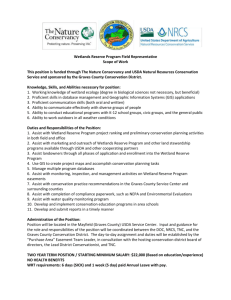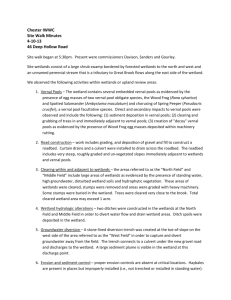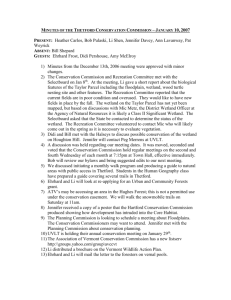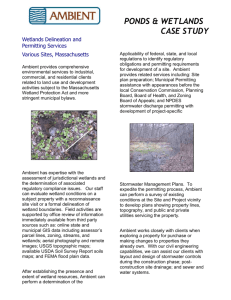12 conservation overlay district - may 2011 draft
advertisement
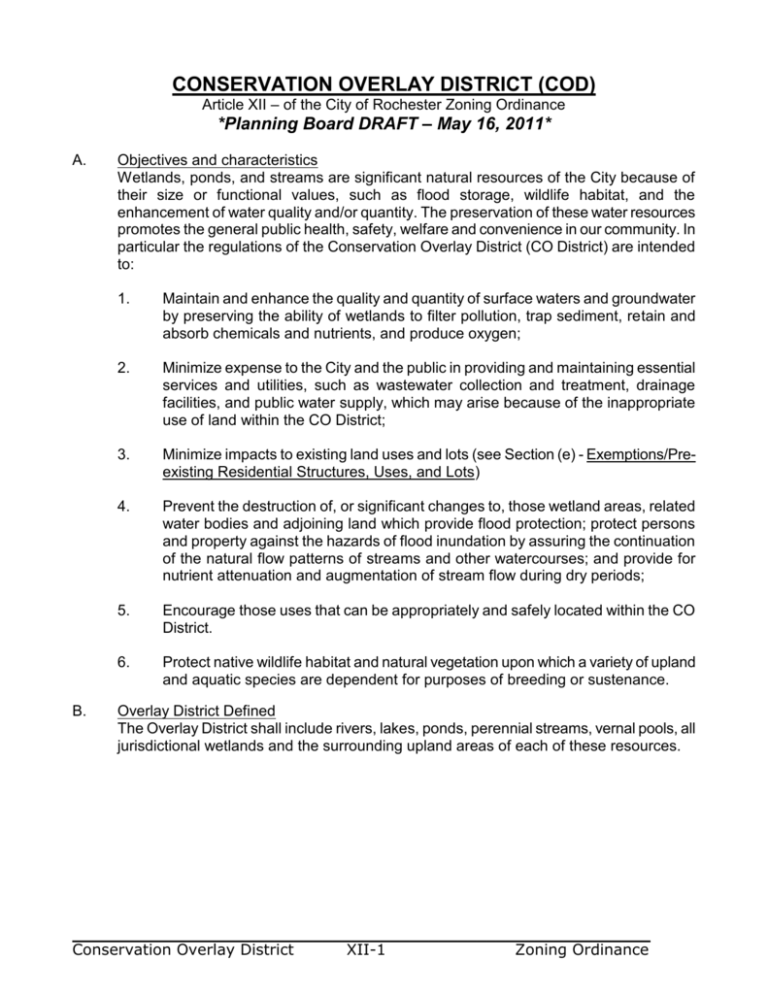
CONSERVATION OVERLAY DISTRICT (COD) Article XII – of the City of Rochester Zoning Ordinance *Planning Board DRAFT – May 16, 2011* A. B. Objectives and characteristics Wetlands, ponds, and streams are significant natural resources of the City because of their size or functional values, such as flood storage, wildlife habitat, and the enhancement of water quality and/or quantity. The preservation of these water resources promotes the general public health, safety, welfare and convenience in our community. In particular the regulations of the Conservation Overlay District (CO District) are intended to: 1. Maintain and enhance the quality and quantity of surface waters and groundwater by preserving the ability of wetlands to filter pollution, trap sediment, retain and absorb chemicals and nutrients, and produce oxygen; 2. Minimize expense to the City and the public in providing and maintaining essential services and utilities, such as wastewater collection and treatment, drainage facilities, and public water supply, which may arise because of the inappropriate use of land within the CO District; 3. Minimize impacts to existing land uses and lots (see Section (e) - Exemptions/Preexisting Residential Structures, Uses, and Lots) 4. Prevent the destruction of, or significant changes to, those wetland areas, related water bodies and adjoining land which provide flood protection; protect persons and property against the hazards of flood inundation by assuring the continuation of the natural flow patterns of streams and other watercourses; and provide for nutrient attenuation and augmentation of stream flow during dry periods; 5. Encourage those uses that can be appropriately and safely located within the CO District. 6. Protect native wildlife habitat and natural vegetation upon which a variety of upland and aquatic species are dependent for purposes of breeding or sustenance. Overlay District Defined The Overlay District shall include rivers, lakes, ponds, perennial streams, vernal pools, all jurisdictional wetlands and the surrounding upland areas of each of these resources. ____________________________________________________________ Conservation Overlay District XII-1 Zoning Ordinance C. Buffer Defined In all cases the more restrictive buffer shall be used. Buffer 75 feet 50 feet Location Cocheco River, Salmon Falls River and Isinglass River from the ordinary high water mark of the river. Named streams and surface water from the ordinary high water mark listed in Table I, below Edge of jurisdictional wetland consisting of very poorly drained soils. (1) Edge of jurisdictional wetland consisting of poorly drained soils. (1) Vernal pools. (2) (1) The precise location of a wetland boundary in any particular case must be determined by on-site inspection by a NH Certified Wetland Scientist. (2) Vernal pools that shall be identified by a NH Certified Wetland Scientist and may be subject to review by the Conservation Commission D. Delineation Process. The edge of wet of these wetlands shall be determined by the delineation process set forth in the Corps of Engineers Wetlands Delineation Manual, 1987, on file with this ordinance with the City Clerk. When there is a dispute in the boundary the landowner may appeal the decision to the Planning Board with written recommendations by the Conservation Commission. E. Exemptions/Pre-existing Residential Structures, Uses, and Lots. The following are exempt: 1. All wetlands less than one-half acre in size, except vernal pools. 2. Wetland conditions resulting from the following: constructed drainage structures including, but not limited to swales, ditches, and basins; actively maintained agricultural/irrigation ponds; septage lagoons. 3. Notwithstanding other provisions of this article, the construction of additions and extensions to one and two family dwellings and accessory residential uses shall be permitted within the CO District provided that: 4. a. The dwelling or residential use lawfully existed prior to the original adoption of the Conservation Overlay District on October 7, 2003 b. The proposed construction conforms to all other applicable ordinances and regulations of the City of Rochester; and c. The dwelling or use continues in its present use. Lots of record except that any lot requiring subdivision (i.e. that creates 2 or more lots) or minor site/site plan review must meet the requirements of this ordinance. ____________________________________________________________ Conservation Overlay District XII-2 Zoning Ordinance 5. Pre-existing Subdivisions, Site Plans. Exemptions: a. Subdivisions, site plans and planned unit developments approved by the Planning Board and existing at the time of passage of this article shall be exempt from this article, as governed by the provision of NH RSA Section 674:39. b. Completed applications approved by the Planning Board are exempt from this article herein. c. Condominium Conversions where there are no improvements proposed to the site are exempt from this article. This ordinance becomes applicable in the following situations: a. Non-Residential Site Plans for additions, expansions, or changes in use. F. b. Site Plans for new commercial, industrial, or multi-family development. c. New subdivisions. Definitions. 1. The term "wetland" as defined by National Food Security Act Manual (Soil Conservation Service, 1994) and the Corps of Engineers Wetlands Delineation Manual (Environment Laboratory, 1987) as amended, will mean those areas that are surface or groundwater at a frequency and duration sufficient to support, and that under normal circumstances do support, a prevalence of vegetation typically adapted for a life in saturated soil conditions. Wetlands include, but are not limited to, swamps, marshes, bogs and similar areas. 2. The term "buffer" means the protected upland areas adjacent to wetlands and surface waters in the Conservation Overlay District other than the wetlands themselves. 3. "Ordinary high water mark" means the line on the shore, running parallel to the main stem of the river, established by the fluctuations of water and indicated by physical characteristics such as a clear, natural line impressed on the immediate bank, shelving, changes in the character of soil, destruction of soil, destruction of terrestrial vegetation, the presence of litter and debris, or other appropriate means that consider the characteristics of the surrounding areas. Where the ordinary high water mark is not easily discernable, the ordinary high water mark may be determined by the Department of Environment Services. Source: Comprehensive Shoreland Protection Act, pg. 7 from the State of NH Web Page, 1998 4. The term "overlay district" means a zoning district superimposed on one or more established underlying zoning districts to impose supplemental restrictions on uses in these districts. ____________________________________________________________ Conservation Overlay District XII-3 Zoning Ordinance 5. "Poorly drained soil" as defined High Intensity Soil Maps for New Hampshire Standards sponsored by the Society of Soil Scientist of Northern New England Special Publication No. 1, Sept. 2002. 6. "Vernal pools" are temporary bodies of water that flood each year for a few months during the spring and summer. Vernal or "spring" pools fill up with melting snow and early rains, then usually dry up by mid to late summer. Some relatively deep pools may remain flooded for a few years but become completely dry in seasons with very low rainfall. Autumnal pools fill during the fall with rising groundwater. Because vernal pools are not permanently flooded, they do not support fish populations and thus provide safe breeding sites for several amphibian and invertebrate species, including wood frogs, spotted salamanders, and fairy shrimp. These species have evolved life cycles that depend on temporary pools. Vernal pools vary in size, ranging from several square feet to several acres. They can be found in a variety of sites, such as isolated depressions in the woods, kettle holes, and gravel pits. Many are within larger wetlands, such as oxbows in river floodplains and pools in forested swamps or scrub-shrub wetlands. Their common characteristics are the absence of fish, temporary flooding regime, and the presence of vernal pool species. Suitable pools must have enough leaf litter and other debris to provide food sources and cover for the species that breed in them. Source: ASNH Conservation Fact Sheet: Vernal Pools 7. G. "Very poorly drained soil" as defined High Intensity Soil Maps for New Hampshire Standards sponsored by the Society of Soil Scientist of Northern New England Special Publication No. 1, Sept. 2002. Buffer Application. Buffers are applied irrespective of lot lines and municipal boundaries except (as shown in the below diagram) that when a wetland is bounded by City Class V or a State or Federal highway, existing at the time of passage of this article, buffers are not applied to properties directly across the right of way. Buffers are applied irrespective of lot lines and municipal boundaries except (as shown in the below diagram) that when a wetland is bounded by City Class V, or a State or Federal highway, existing at the time of passage of article, buffers are not applied to properties directly across the right of way. ____________________________________________________________ Conservation Overlay District XII-4 Zoning Ordinance CO District Wetland Street/ Right of Way Property Lines NO BUFFER ON PROPERTIES DIRECTLY ACROSS THE STREET H. Uses Allowed. 1. The CO District is an overlay district. Where the provisions of this Section conflict with those of the underlying zoning district, the more restrictive standards shall apply. 2. The following uses are allowed in this District: a. Wildlife habitat development and management. b. Conservation areas and nature trails, provided that the Planning Board, in consultation with the Conservation Commission, reviews and approves plans of such areas and trails prior to their development. c. Recreation including open-air recreational uses consistent with the purpose and intent of this article, such as cross-country skiing, ice skating, hiking, and photography. d. Education including natural and environmental science walks, wildlife and botanical studies and similar activities. e. Seasonally permitted hunting and fishing, as regulated by New Hampshire Fish and Game Department. f. Forestry, including both logging operations and tree farming subject to RSA 227-J: 9. Logging and any associated road building and/or skid trail construction shall be conducted in accordance with the then-current Best Management Practices for Erosion Control on Timber Harvesting Operations in New Hampshire published by the UNH Cooperative Extension and NH Department of Resources and Economic Development and the NH Division of Forests and Lands; on file with this ordinance with ____________________________________________________________ Conservation Overlay District XII-5 Zoning Ordinance the City Clerk; g. Production, cultivation, growing, and harvesting of any fruit, vegetable, floricultural or horticultural crops, conducted in accordance with Best Management Wetlands Practices for Agriculture (July 1993, amended September 1998; (on file with this ordinance with the City Clerk) but not within 25 feet of the edge of wet of the adjacent wetland. h. The land surface within 25 feet of the edge of the wetland shall not be altered. Herbicides and heavy equipment are prohibited within 25 feet of the edge of the wetland. New lawns may be established beyond 25 feet from the edge of the wetland provided the wetland has been delineated/flagged by a Certified Soil Scientist. Fertilization shall be limited to lime and woodash. i. Removal of hazardous trees. j. Removal of "invasive" vegetation (see "Notes on Native Trees and Shrubs and Their Use in Landscaping", by the Rochester Conservation Commission, on file with this ordinance with the City Clerk). k. Minor accessory structures of 200 square feet or less (in which there is no storage of petroleum products, hazardous chemicals or materials). Such accessory structures shall not be constructed with any of the following materials: asphalt shingles or pressure treated or chemically treated/preserved wood. Any uses not listed in this Section are prohibited in the CO District. I. Conditional Use Approvals. Conditional use approval may be granted by the Planning Board (RSA 674:21 II) after proper public notice and public hearing. 1. The following uses are allowed with a Conditional Use Approval: a. Roads and other access ways; drainage ways; pipelines, power lines and other transmission lines; docks, boat launches, and piers;domestic water wells (and associated ancillary pipes and equipment); replacement septic tanks and leach fields where evidence is submitted that no alternative location is available on the property; provided that all of the following conditions are found to exist: i. The proposed construction is essential to the productive use of land not within the CO District. ii. Design and construction methods will be such as to minimize impact upon the wetlands and will include restoration of the site consistent with the permitted use. ____________________________________________________________ Conservation Overlay District XII-6 Zoning Ordinance 2. iii. There is no feasible alternative route on land controlled by the applicant that does not cross the CO District nor has less detrimental impact on the wetlands. Nothing in this Section shall limit the applicant from exploring alternatives with abutting property owners. iv. Economic advantage is not the sole reason for the proposed location of the construction. Buffer reductions: a. Lots which are subject to the requirements of this CO District as defined in Sections (b) and (c), above, may be allowed a buffer reduction of no more than one-half (1/2) of any required buffer subject to all applicable provisions of the Zoning Ordinance, in the following situations: b. i. Expansion of existing structures may be permitted for lots located in the Industrial I, Industrial 2, Industrial 3, Business 1, and Business 2 districts ii. Construction of a new structure may be permitted for lots located in the Industrial I, Industrial 2, Industrial 3, Business 1, and Business 2 districts. All the following conditions shall be met to allow buffer reductions: i. The structure for which the exception is sought cannot feasibly, after consideration of all reasonable alternatives, be constructed on a portion or portions of the lot, which lie outside the CO district, or the application of the CO district eliminates greater than 50% of the buildable area located on the parcel or in the judgment of the Planning Board, the proposed site layout would result in a significantly higher quality design. ii. The proposed structure and use must be consistent with the purpose and intent of this article and provisions must be made to ensure that drainage from the structure will not adversely impact any wetlands. iii. There shall be no impervious areas for parking within the reduced buffer for which the Conditional Use Approval is sought. iv. The maximum building coverage is limited to 50% of the outer half of the buffer zone, as shown in the diagram below. v. Best management practices must be demonstrated to the satisfaction of the Planning Board. ____________________________________________________________ Conservation Overlay District XII-7 Zoning Ordinance Buffer Reduction Examples Allowed Building Footprint WETLAND Outer half Inner half Buffer lines Not Allowed Building Footprint WETLAND Outer half Inner half Buffer lines c. Buffer reduction may also be obtained explicitly by issuance of a NH DES Dredge and Fill Permit, per section (j) Dredge & Fill Permits. d. Administration of Conditional Use Approvals. i. The application shall be referred to the Conservation Commission for review and comment prior to the Planning Board making any final decision. In acting on the application, the Board shall consider any report received from the Commission. The Board shall then vote either to approve the application as presented, approve it with ____________________________________________________________ Conservation Overlay District XII-8 Zoning Ordinance conditions, or deny it. J. ii. Prior to the granting of any Conditional Use Approval under (i) Conditional Use Approval (1) and (2), the applicant may be required to submit a performance security in a form acceptable to the Planning Board, depending on the scale of the proposed use and potential threat to the wetlands. The security shall be submitted in a form and amount with surety and conditions satisfactory to the Planning Department to ensure that the construction will be carried out in accordance with the approved design. The security shall be submitted to and approved by the Planning Department prior to the issuance of any permit authorizing construction. iii. The Planning Board may require the applicant to submit a wetlands impact assessment when necessary to evaluate an application made under this Section. The cost of this assessment shall be borne by the applicant. iv. As outlined in NH RSA 676:4 I(g) the applicant may also be assessed reasonable fees to cover the cost of other special investigative studies and for the review of documents required by particular applications, reviews by the City's legal counsel, and any third party wetlands consultant as may be required by the Planning Board. Dredge and Fill Permits. 1. Dredge and Fill Permits a. Prior to filing an application for a New Hampshire Department of Environmental Services (NH DES) dredge and fill permit, the applicant is strongly encouraged to meet with the Conservation Commission to ensure that the proposed dredge and fill is consistent with the intent of the ordinance b. An approved NH DES dredge and fill permit, once acted upon, will change the CO District Boundary, which will be applied from the new edge of wetland. K. Mitigation. CO District mitigation shall be provided in the same watershed, if required by the Planning Board, at its discretion, with consideration of recommendations by the Conservation Commission. L. Prohibited Uses/Activities. 1. Expansion of motor vehicle recycling and junkyards is prohibited. 2. There shall be no storage of petroleum products, hazardous chemicals or materials. ____________________________________________________________ Conservation Overlay District XII-9 Zoning Ordinance 3. Accessory structures shall not be constructed with any of the following materials: asphalt shingles or pressure treated or chemically treated/preserved wood. 4. There shall be no parking or storage of unregistered vehicles. M. Board of Adjustment Note. Any variance or appeal to the Zoning Board of Adjustment, shall be in accordance with NH RSA 676:5 and Article IV of this Zoning Ordinance. Prior to holding a public hearing on an appeal or variance, the Zoning Board shall forward a copy of the plan and application to the Conservation Commission for review and comment. The Conservation Commission shall, after reviewing the plan and application, forward any appropriate recommendations to the Zoning Board of Adjustment for its consideration. N. Very Poorly Drained Soils. Any wetland or part of any wetland consisting of very poorly drained soils shall not count toward the minimum lot area or density requirements of any property in any zoning district. TABLE I NAMED STREAMS AND SURFACE WATER TABLE Axe Handle Brook (Rickers & Howard Brooks) Heath Brook Hurd Brook Willow Brook AKA Wardley Brook Clark Brook Baxter Lake Rochester Reservoir Hanson Pond AKA Squamanagonic Pond Little Long Pond Champlin Pond No name pond south of Champlin Pond NOTE: The above streams have been identified in the Water Resource Management and Protection Plan, prepared by Southern New Hampshire Planning Commission, dated February 1991 and on file in the office of the Planning Board, as listed in Table I. " ____________________________________________________________ Conservation Overlay District XII-10 Zoning Ordinance
